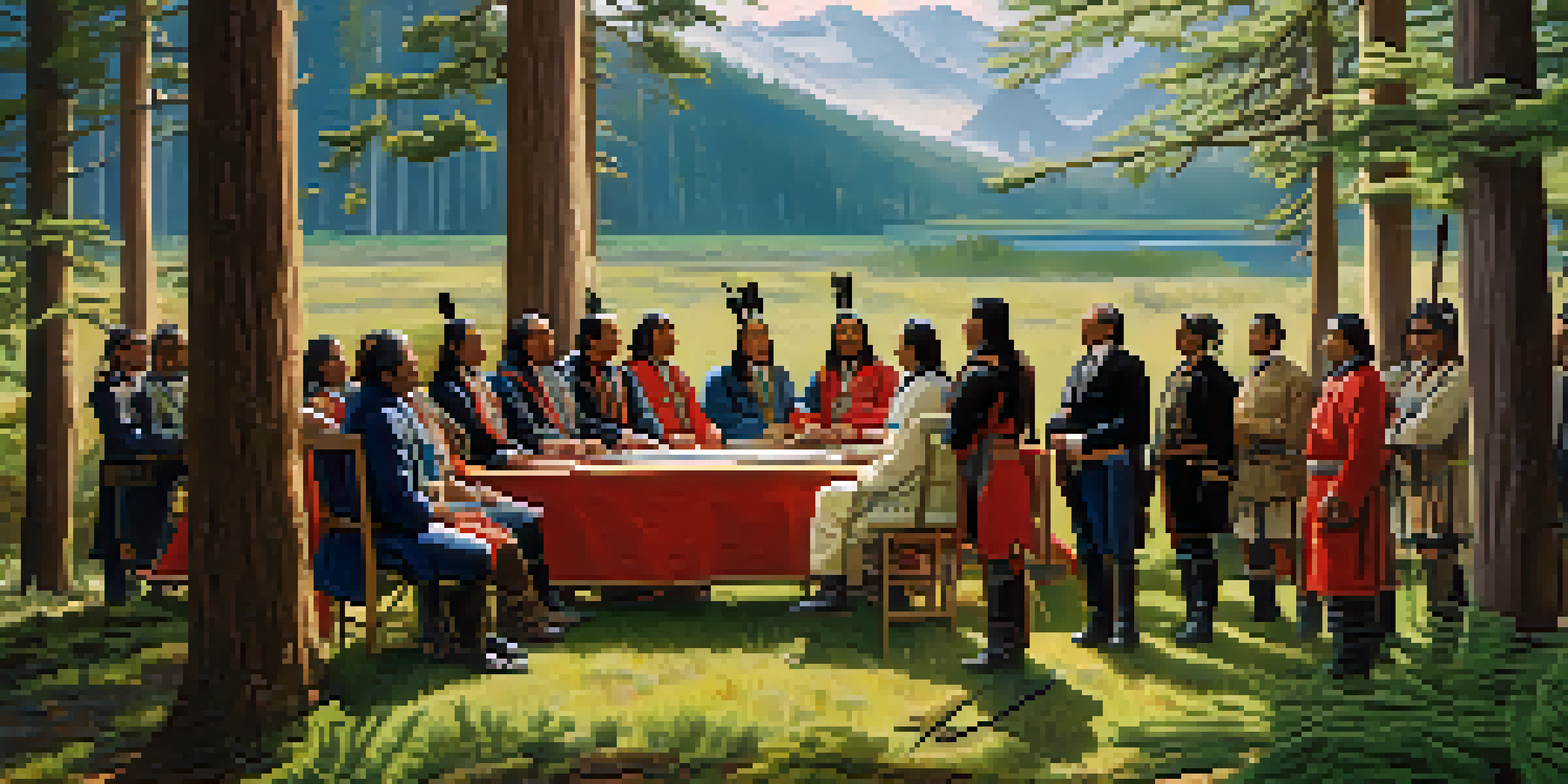The Treaty of Medicine Creek and Its Historical Impact

Understanding the Treaty of Medicine Creek
The Treaty of Medicine Creek, signed in 1854, was a pivotal agreement between the U.S. government and several Native American tribes in the Pacific Northwest. This treaty aimed to establish peace and define land rights for tribes, primarily the Nisqually, Puyallup, and Squaxin Island peoples. It marked a significant moment in U.S. history, as it reflected the government's approach to Native American relations during westward expansion.
Treaties are the supreme law of the land, and they must be honored and respected.
At the heart of the treaty was the cession of vast lands to the U.S. in exchange for reservations and certain rights. The tribes agreed to relinquish their traditional territories, which had sustained them for generations, hoping for security and continued access to resources. However, the terms of the treaty were often misunderstood or misrepresented, leading to future conflicts.
The signing of this treaty can be seen as a double-edged sword: while it brought about a temporary peace, it also set the stage for ongoing struggles over land and sovereignty that would affect Native American communities for decades to come.
The Context of the Treaty
To fully grasp the significance of the Treaty of Medicine Creek, we need to consider the broader historical context. The mid-19th century was a time of intense change in the Pacific Northwest, driven by the influx of settlers and the promise of new opportunities. The discovery of gold and fertile lands led to increased tensions between Native tribes and European American settlers.

The U.S. government, eager to expand its territory and secure resources, sought to negotiate treaties, often under pressure or coercion. Many Native tribes were caught off guard by these negotiations, as they had their own systems of governance and land use that were often overlooked by the government representatives. The Treaty of Medicine Creek was one such example of these complex dynamics.
Treaty Established Land Rights
The Treaty of Medicine Creek aimed to define land rights for Native American tribes in exchange for reservations and certain rights.
Understanding this context is crucial, as it underscores the difficult choices faced by Native communities at the time. The treaty was not just a legal document; it was a response to existential threats to their way of life.
Key Provisions of the Treaty
The Treaty of Medicine Creek consisted of several key provisions that aimed to secure certain rights for the tribes involved. Among these was the establishment of designated reservations, where tribes could continue their traditional practices and maintain some autonomy. This was a significant concession, as it allowed tribes a semblance of control over their lives, albeit in a much-reduced capacity.
The greatest tragedy of the American Indian is that they are not a part of the American fabric, and yet they are the first Americans.
Additionally, the treaty guaranteed rights to hunt, fish, and gather in their usual places, a crucial aspect of their culture and sustenance. However, these rights would later be challenged, leading to further disputes and legal battles. The contrast between the treaty's promises and the reality that followed would become a defining theme in the history of Native American relations.
Ultimately, the provisions of the treaty were designed to benefit the U.S. government while providing Native tribes with limited assurances. This imbalance laid the groundwork for future grievances that would resonate throughout the region.
Immediate Reactions to the Treaty
The immediate reactions to the Treaty of Medicine Creek were mixed among the Native tribes and settlers. For many tribes, signing the treaty was seen as a necessary step to ensure their survival amidst the encroaching settlers. Some leaders believed it was a pragmatic way to negotiate for their people's future, while others felt it was a betrayal of their ancestral lands and heritage.
Settlers, on the other hand, had varying perspectives, with some viewing the treaty as a way to establish order in the region. However, many settlers were eager to exploit the newly acquired lands, often disregarding the treaty's stipulations. This led to a growing resentment among Native tribes, as they witnessed the erosion of their rights and resources.
Ongoing Struggles for Sovereignty
The treaty set the stage for decades of conflict over land and sovereignty, highlighting the complex relationship between Native tribes and the U.S. government.
These immediate reactions highlight the complexity of the situation, where different stakeholders had divergent interests. The initial hope for peace quickly gave way to tensions that would escalate in the years following the treaty's signing.
Long-Term Consequences of the Treaty
The long-term consequences of the Treaty of Medicine Creek were profound and far-reaching. One of the most significant outcomes was the continued loss of Native lands as settlers encroached on the reservations. This relentless pressure led to a cycle of displacement and poverty for many Native communities, undermining their ability to thrive.
Moreover, the treaty's promises regarding hunting and fishing rights were frequently violated, sparking numerous legal battles. Native tribes found themselves in a constant struggle to assert their rights and protect their way of life against state and federal policies that often favored expansion and exploitation.
Ultimately, the Treaty of Medicine Creek became a symbol of broken promises and the ongoing challenges faced by Native American communities in their fight for recognition and sovereignty. Its legacy is a reminder of the importance of honoring agreements and respecting the rights of Indigenous peoples.
The Role of Activism and Legal Battles
In the decades following the signing of the Treaty of Medicine Creek, Native communities began to organize and advocate for their rights. Activism emerged as a crucial response to the ongoing injustices they faced, with leaders and grassroots movements pushing back against the encroachment of settlers and the government. This activism laid the groundwork for a broader Indigenous rights movement in the United States.
Legal battles became a significant avenue for Native tribes to reclaim their rights. Landmark cases throughout the 20th century, such as the Boldt Decision in 1974, reaffirmed the tribes' rights to fish and gather in their usual places, based on the treaty's provisions. These victories were hard-fought, often requiring years of struggle and perseverance.
Legacy of Activism and Resilience
In response to historical injustices, Native communities have organized activism and legal battles to reclaim their rights and assert their sovereignty.
The role of activism and legal battles highlights the resilience of Native communities and their commitment to preserving their culture and rights. It also underscores the ongoing relevance of the Treaty of Medicine Creek in contemporary discussions around Indigenous sovereignty and justice.
The Treaty Today: An Ongoing Legacy
Today, the Treaty of Medicine Creek continues to resonate within Native communities and beyond. It serves as a reminder of the historical injustices faced by Indigenous peoples and the importance of understanding these legacies in the context of current events. As discussions around land rights and sovereignty gain traction, the treaty remains a critical touchstone.
Many tribes involved in the treaty have worked to revitalize their cultural practices and assert their rights in modern society. By engaging with their history and advocating for justice, they are reclaiming their narrative and fostering a sense of pride among younger generations. This cultural resilience is a powerful testament to the enduring impact of the treaty.

As we reflect on the Treaty of Medicine Creek, it becomes clear that its legacy is not just a relic of the past but a living part of the ongoing story of Indigenous rights. It challenges us to consider how we can support justice and equity for Native communities today.